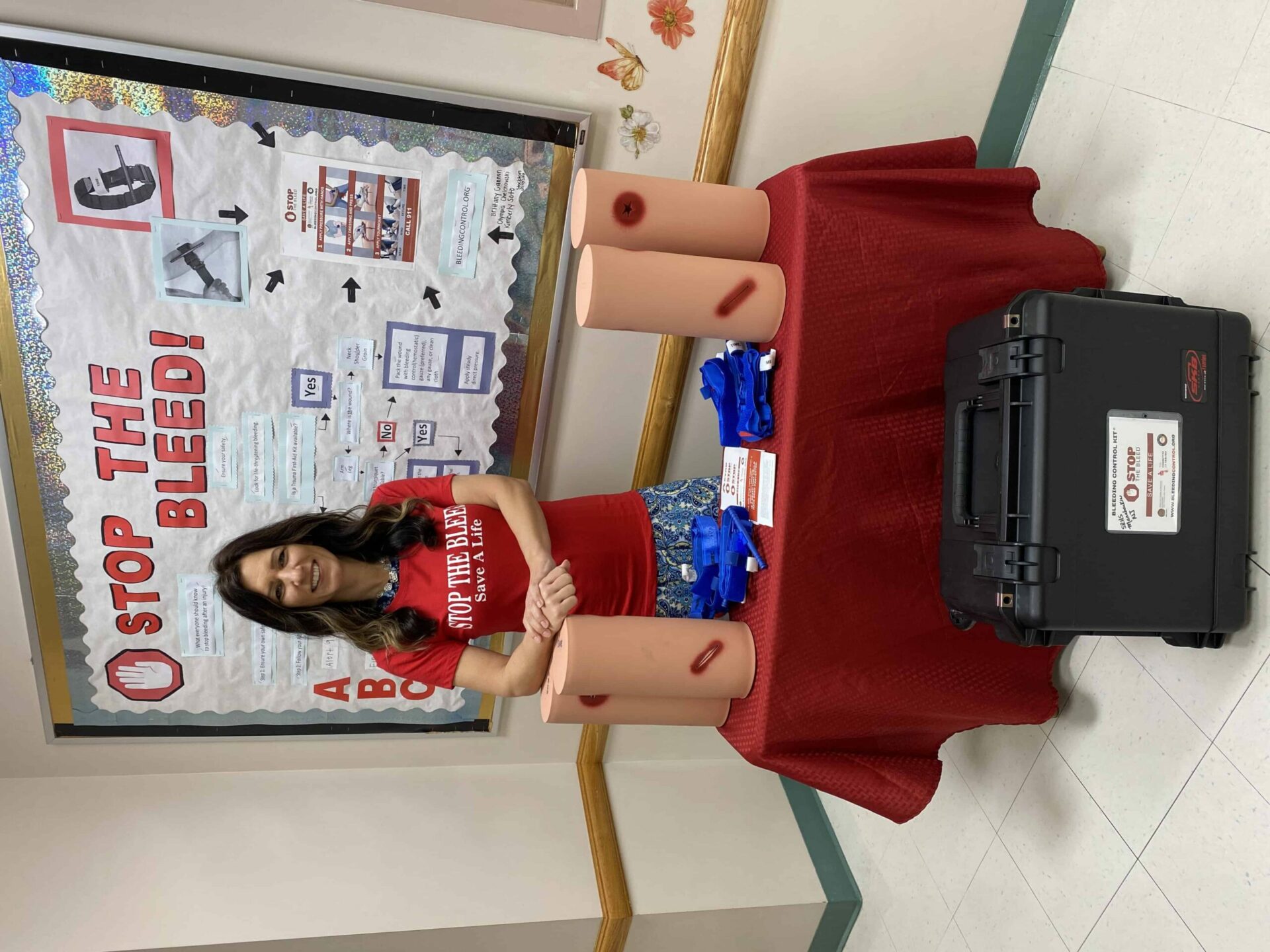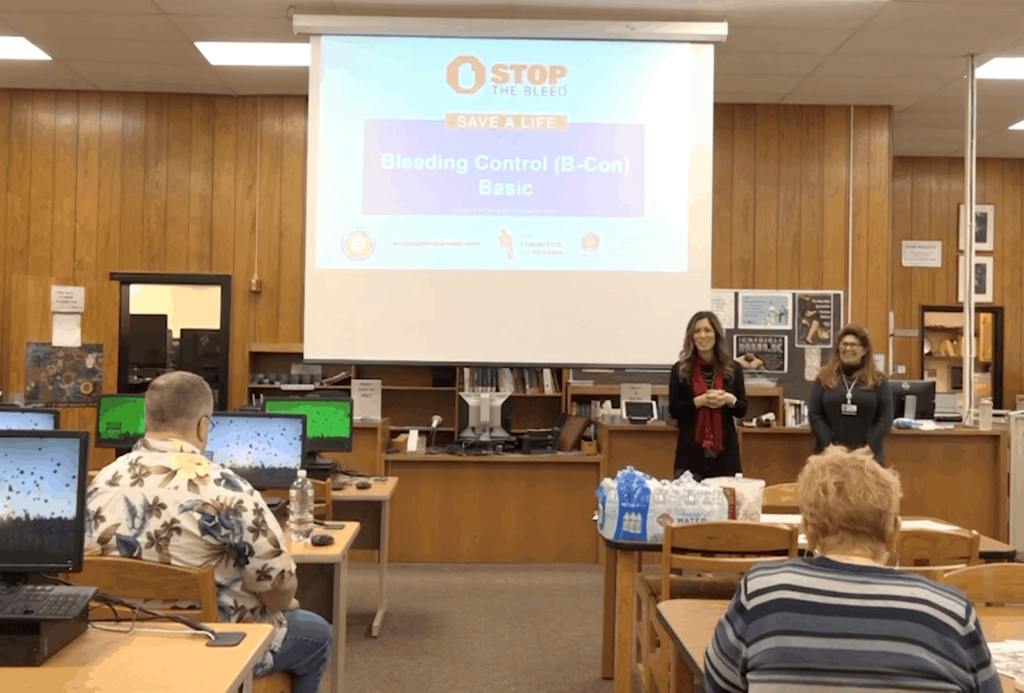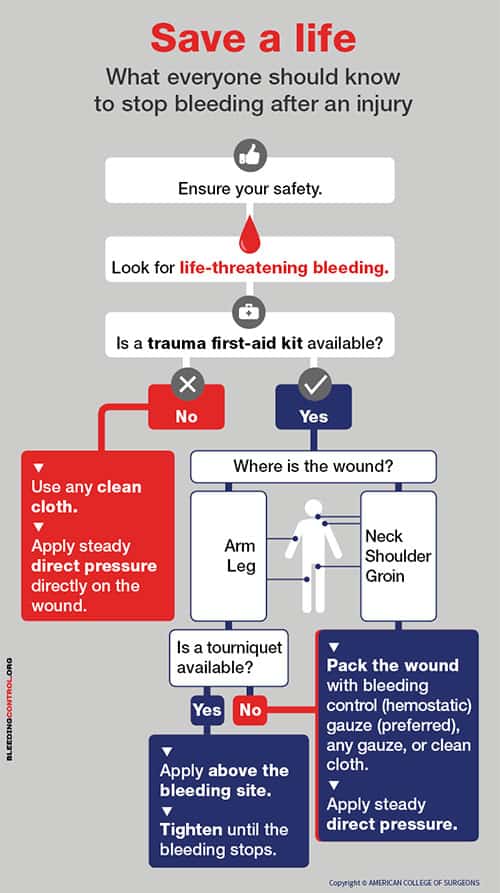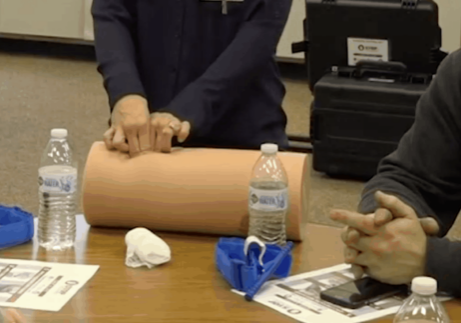Stop the Bleed programs in school settings saves lives
By Kathryn Bates, MSN, RN, NCSN
“Never become complacent.”
These were the opening words of Southern Regional Superintendent Craig Henry’s annual welcome back speech in 2018 to our entire school’s staff. Those words resonated with me and inspired me to implement a program I had been involved with for some time: the Stop the Bleed program.
Initially, I was interested in the program and the educational opportunities it could provide. I was introduced to Tracy Nerney, the primary educator and coordinator for Trauma Injury Prevention at the Jersey Shore Regional Trauma Center, who explained the Stop the Bleed program to me. She was energetic and excited to share her newly formed program, the stark opposite of complacency. Her fervor for this educational program drew me further toward her goal and brought my attention to how vital this topic is for the safety of our communities at large.

Stop the Bleed initiative
Nerney and her team of nurses and volunteer emergency medical technicians (EMTs) were kind enough to bring their presentation to nearly 50 staff members at Southern Regional High School. They came with a large suitcase filled to the brim with fake legs, gauze and tourniquets. Nerney and her entourage showed a PowerPoint detailing the importance of the tourniquet, gauze, and, most importantly, taking action in an emergency. We split up into small groups where an instructor demonstrated proper technique, and we participants demonstrated what we learned using pressure, wound packing and tourniquet application on fake legs.
When life threatening bleeding occurs, it can take upwards of 15 minutes for first responders to arrive. Within this time frame, who has the training to stop the bleeding?
In a school setting, nurses, staff and other students can intervene during this type of crisis. Implementation of the Stop the Bleed course in schools allows people to provide life saving techniques during a dire situation. Blood loss can cause a person to go into shock and if it is not treated immediately, death is imminent. Having public access to a kit containing gloves, dressings, and a tourniquet as well as a prior knowledge is essential to prompt treatment.
The Hartford Consensus III (Jacobs, L. M., 2015) states that death can be preventable during the prehospital phase of a traumatic injury. The Hartford Consensus was established after the 2012 Sandy Hook tragedy and gathered law enforcement, government agencies, military personnel and the medical community to discuss how to improve survival when a person is bleeding to death (American College of Surgeons (ACS), 2015). The movement initiated by the Hartford Consensus is what prompted the creation of the Stop the Bleed program.
Responders, such as school staff members or students who participate in this nationally funded course learn how to use direct pressure, pack a wound, and apply a tourniquet for injuries when there is uncontrolled and life-threatening bleeding until emergency personnel arrive. Every action and every minute counts in a life-or-death situation, and this program aims to emphasize that idea.

Inside and outside the classroom
The Stop the Bleed program received such positive feedback from the attendees and was viewed as so invaluable by staff, that I decided to present it to Health and Physical Education Supervisor Joe DiPietro. We agreed that this initiative would be beneficial for our high school students.
We purchased the Stop the Bleed training kit through the health and physical education budget for $950. The kit included five tourniquets and two manikin legs. With the help of our athletic trainer, Nick Scaramazza, and a volunteer emergency medical technician (EMT), Chris Strunck, we began training all seniors during their health class last school year. Students received a certificate for successfully completely the hourlong training. This is a one-time training, and there is no cost to the attendees. In contrast, the American Heart Association and American Red Cross charge a fee for this training.
I soon found that I needed more equipment as the program became popular and additional supplies were needed. I was awarded a grant through my union, the Southern Regional Education Association, to purchase four extra tourniquets and two more training legs. This was extremely important because it allowed me to train a larger group with more available equipment. This in turn gave all participants the needed experience to go out and stop a life-threatening injury no matter where they might find themselves needing it.
The course itself
The Stop the Bleed course teaches participants to recognize severe bleeding and the significance of maintaining personal safety when caring for a victim. Rescuers are instructed to survey the scene and deem whether it is safe to implement first aid. Emergency medical services must be notified immediately, so that there is no delay transporting the victim to a medical center.
The rescuer must immediately identify the source of the bleeding and apply direct pressure with gloved hands. If gloves are not available, any type of barrier, such as a bag or an article of clothing, will suffice. Arm and leg wounds are the most frequent cause of preventable death from a hemorrhagic injury and can be controlled by applying a tourniquet or through direct pressure if a tourniquet is not available.
Wounds to the junctional area of the torso, neck, or shoulder will benefit from gauze packing and direct pressure. Because of an increased risk of death from chest and abdominal injuries, these victims are more difficult to manage. Most internal bleeding cannot be controlled by external measures, so these victims must be immediately transported to a trauma center.
The Stop the Bleed course also states that direct pressure using any type of clean cloth is appropriate. However, during times when a clean cloth is unavailable, any type of cloth can be used. It is important to stop the bleeding using both hands to apply firm and continuous pressure directly over the wound. At no point in time should the pressure be released as this could allow for a resurgence of bleeding and compromise the victim.
If there is uncontrolled bleeding from a wound on an extremity and a tourniquet is available, it should be placed two inches above the wound injury, over clothes, and never applied directly over a joint or a pocket containing items. The tourniquet is tightened until the bleeding stops.
The tourniquet should never be removed once it is placed. If there is continuous bleeding after the first tourniquet has been placed, a second tourniquet may be applied a few inches directly above the initial tourniquet to control bleeding.
The time that the tourniquet was applied should be written on the tourniquet—preferably with a permanent marker. The tourniquet should never be loosened or removed. A properly applied tourniquet is uncomfortable and will cause pain; therefore, responders must reassure the victim that the bleeding has stopped and that the tourniquet must stay in place until they reach a medical facility.

Bringing the program to your school
The Southern Regional School District in Manahawkin has further incorporated the Stop the Bleed program into the junior class’s health education curriculum and is no longer limited to senior students. The orientation program for new staff also implements the program and continues to this day.
While all school staff can be trained in the Stop the Bleed program, most are not eligible to become a Stop the Bleed instructor in New Jersey. School nurses and those with a medical background who are interested in becoming an instructor should visit the Stop the Bleed website at
stopthebleed.org to locate trauma centers and sites that can assist in their instructor training. There is no cost for the training.
The website also has additional resources such as educational videos and posters (see Figure 1). The instructor to student ratio is 1:10, so it may be necessary to seek out other certified individuals within the school, local trauma centers or the community to assist the school nurse during the trainings. The Stop the Bleed program recommends specific professionals such as nurses, athletic trainers, occupational therapists, physical therapists and emergency medical responders to assist the school nurse with program instruction and implementation.
Unfortunately, because of COVID-19, we have had to put our program on hold for most of this school year. But on April 1 we will be teaching the course to juniors in a way that comports with pandemic safety guidelines.
Future of the program
Federal legislation is currently being considered to have equipment readily available for the community. In February 2020, U.S. Sens. Bob Menendez (D-N.J.) and John Boozman (R-Ark.) introduced S-3346, the Prevent Blood Loss with Emergency Equipment Devices Act of 2020, also known as the Prevent BLEEDing Act of 2020. This act would provide funding for states to make bleeding kits available in public buildings and public spaces.
Some states have already enacted laws requiring students to learn the program and/or to have the equipment available for an emergency; however, this is not enough. School nurses and staff who participate in the Stop the Bleed course can educate others to quickly identify life-threatening bleeding and provide bleeding control measures. These lifesaving actions can improve outcomes and save lives in school and in our communities.
At stopthebleed.com, ACS notes that over 1 million people have been trained in this course, but there are still close to 280 million people in the United States who have little to no knowledge about this training. As ACS says, “The only thing more tragic than a death from bleeding, is a death that could have been prevented.” I hope others will see the value of this program and one day when action is needed, they can stop the bleed.
Since 2015, Kathryn Bates has been a school nurse at Southern Regional High School in Manahawkin. Prior to this, she worked as an elementary school nurse for 10 years. Bates is also a volunteer instructor for the Stop the Bleed program. She can be reached at kbates@srsd.net.
Resources
American College of Surgeons. (2021). Stop the Bleed. Retrieved from stopthebleed.org.
American College of Surgeons. (2015). Stop the Bleed. Retrieved from bit.ly/3rLW9dV.
Jacobs, L. M., Joint Committee to Create a National Policy to Enhance Survivability from Intentional Mass Casualty Shooting Events. July 1, 2015. Retrieved from bit.ly/3rmoCUt.
Prevent BLEEDing Act of 2020 bit.ly/stb3346
